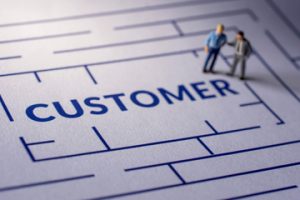Adopt Agile Technology Solutions to Provide Customers
What They Need, When They Need It
Low interest rates, soft demand, and flat non-interest income are resulting in anemic revenue growth and greater margin compression across the banking industry. Adding to these pressures, banks also face changing customer demands and increasing market competition from non-bank entrants.
In this market environment, keeping existing customers is a must, and growing existing relationships are the clearest path to improving revenue growth. But in CEB’s experience, banks find this challenging as non-bank competitors can offer banking customers new options, better aligned to the latest customer needs.
The Customer Loyalty Challenge
Unsurprisingly, building loyalty with customers is a top priority in commercial banking, according to a CEB survey of more than 1,500 business owners from eight countries, designed to understand how different business owners make purchase decisions.
Loyal customers are those who bought products only from their primary financial provider, or those who plan to only buy from their primary financial provider in the future. CEB found that over half of business owners are disloyal. More than half of business owners bought from someone other than their primary financial provider in the past year, and more than half plan to go to a secondary provider in the future.
Key Issues Facing Commercial Banking Executives
Percentage of Respondents Who Ranked Concerns as “1” or “2” on a Four- Point Scale Where “1” Reflected Me Critical Business Category AND “4” Reflected Least Critical
Most Critical Components of Customer Experience and Segmentation
Percentage of Respondents Who Ranked Concerns
as the Most Critical in the “Customer Experience
and Segmentation” Category for Their Bank in the
Next 6-12 Months
Understand Loyal Buyers
Some customer segments are more loyal than others. The length of a customer’s relationship with their provider, age of the customer’s business, and even age of the business owner, all impact the likelihood that a customer will be loyal. The most loyal customers have been with their primary provider for 7-10 years, and are In businesses that are expanding and under six years old. Loyal customers also tend to purchase business lines of credit and term loans.
Identify and Respond to Customer Needs
Our most important finding about loyal customers was that they rely on their financial provider to help them identify product needs, more so than all other customers. Fifty-seven percent of loyal customers made their purchases after they learned from their primary provider that their business has a need for a product or service. For this segment, their primary financial provider is a business partner, not just a supplier.
To improve customer loyalty, banks must quickly identify and respond to customer needs, and provide a level of integration with customer workflows representative of a business partner. This requires banks to understand changing customer demands and current market conditions, and to provide the products and services to match. Without agile IT architecture and new banking solutions, banks will struggle to quickly, easily, and cost-effectively provide the products and services needed to meet diverse customer needs.
Enabling Technology
Technology investments play a vital role in enabling banks to stand out in a crowded marketplace and improve customer loyalty, thus increasing margins and revenue growth. Being able to quickly identify and respond to a likely buyer is the difference between a sale and forfeited revenue. In order to deepen customer relationships, banks must be able to help the customer achieve their business goals, which requires awareness of what those goals are, knowing when to provide guidance, and having the agility to provide the product bundle to support those goals. To accomplish this, we see financial institutions making investments in the following capabilities:
■ Opportunity identification: Develop data and analytics capabilities to predict customer buying behavior to define likely buyers, find the most valuable customer segments, and identify new product bundles.
■ Flexible product and service design: Enable rapid creation of new product bundles—even by non-technical personnel and with direct input from customers—with agile IT systems, including simplified IT architecture and/or adoption of service-oriented architecture (SOA).
■ Real-time responsiveness to customer needs: Use a 360-degree view of a customer and agile banking solutions to quickly create offers and product bundles in response to a customer’s need at the moment their need arises.
■ Customer-planning support: Deliver personalised support and help customers create their business plans—including future banking needs—by using customer data, analytics, and market intelligence to determine the growth path for their business.







